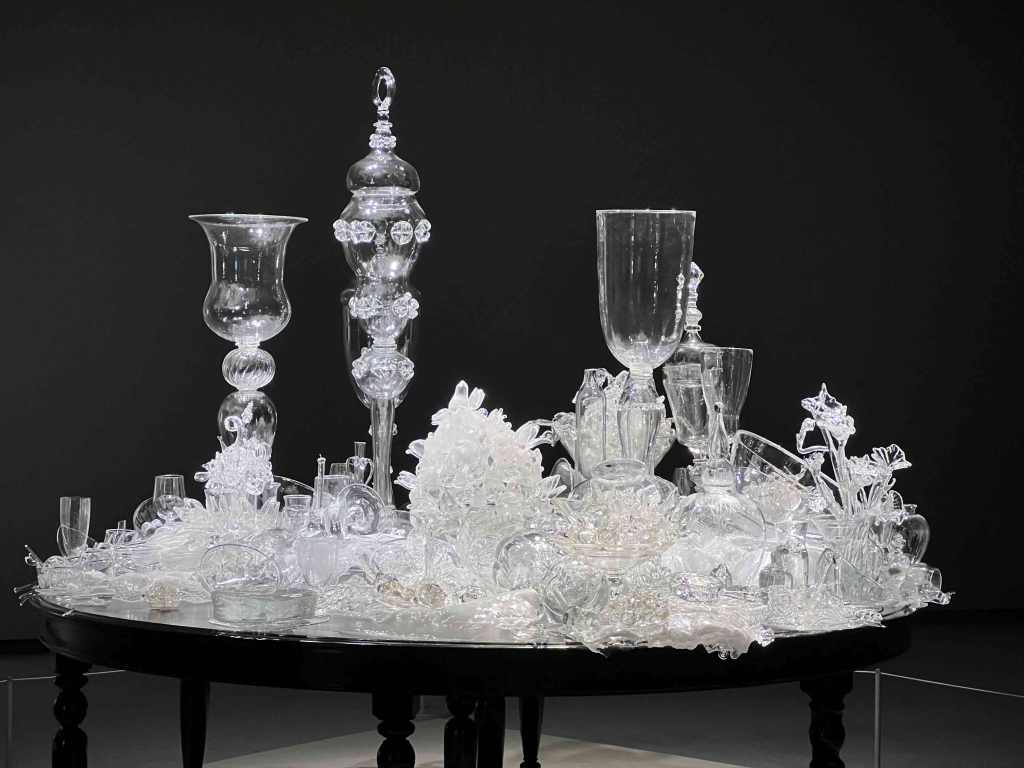In my quest to put ideas into the creative hopper this summer, I went to see Beth Lipman’s still life show, All in Time, at the Wichita Art Museum.
In our pseudo-post-COVID state, we’ve all been working to figure out what is still life, and what we want to preserve. Do we go into the office in a button-up shirt or work from the kitchen table in a sweatshirt, today? Do we stay in the not-a-city we moved to or go back to the office metro? Do we vaccinate the kids for school or continue wearing all the hats for home school? COVID turned everything upside down once and it’s doing it again for what is still life.
Beth Lipman’s glass artwork showing at the Wichita Art Museum, gives visual form to this question, what is still life? In the art world a “normal” still life is often a 2D oil painting of fruit, game, vases, flowers, and insects, with dark somber backgrounds, usually large, hung on a wall, most famously by any number of Dutchmen. Here is one of my favorites:

Lipman’s still life below is the opposite in almost every way.

There’s a table, sure. The table is full of the same fruit, game, vases, flowers, and insects. But the table is 3D, on the floor, not on the wall and the objects are all made of clear glass. And the artist is not Dutch and is not a man.

The fragility of Lipman’s still-life glass feels very much like that of our pseudo-post-COVID still-life definitions, both diaphanous and frangible.
While we think of still-life as something in an art museum, you and I also group objects together to make meaning and cherish memories. Maybe you see an example right now in your home, on your desk, or in your office. Here’s an example of a beautiful arrangement by my mother. Each object speaks a tympanic memory, an oral history of what’s valuable, and together they compose a symphony of good memories.

Likewise, we preserve a memory of pre-COVID life. The new pseudo-post-COVID version of life, while it has advantages, is devoid of some things that used to bring color and solidity to life.
We’ve had 2 years of expectations turned entirely upside down, and now that we have the opportunity to reinstate a normal we may not know what’s best.
Be patient toward all that is unsolved in your heart and try to love the questions themselves, like locked rooms and like books that are now written in a very foreign tongue. Do not now seek the answers, which cannot be given you because you would not be able to live them. And the point is, to live everything. Live the questions now. perhaps you will then gradually, without noticing it, live along some distant day into the answer.
Rainer Maria Rilke, Letters to a Young Poet

Like Rilke, we may not have answers to how am I going to do life now? What is still life now? Much is unresolved. Instead of answers, we are living the questions. Sometimes, living the questions feels like sitting underneath Lipman’s Living History sculpture, a 3-ton boat of glass that careens inexorably, irretrievably, stubbornly from the high ceiling toward us below. Living the questions now seems especially precarious and yet it also seems to be an accurate assessment of the way forward. And looking at it that way makes me feel more comfortable with not having all the answers.
Living the questions might just be an act of faith.
Now faith is the substance of things hoped for, the assurance of things not seen.
Hebrews 11:1 The Message
Resources
Find out more about Beth Lipman at the Wichita Art Museum and on her website. Lipman’s work is in the permanent collections of the de Young in San Francisco and Brooklyn Museum in New York.
